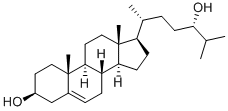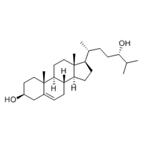24(S)-hydroxy Cholesterol is a side-chain substituted oxysterol that has important roles in cholesterol homeostasis. It is generated by the action of CYP46 on cholesterol in the brain and diffuses across the blood-brain barrier to the systemic circulation where it can modulate cell signaling, be used for further sterol biosynthesis, or be metabolized in the liver. 24(S)-hydroxy cholesterol potently activates LXRα and LXRβ nuclear receptors (EC50 = 4 and 3 μM, respectively), causing upregulation of cholesterol-lowering genes. In the brain, this oxysterol controls cholesterol processing to facilitate neurological repair during Alzheimer’s disease and other neuropathological conditions.
(3β,24S)-Cholest-5-ene-3,24-diol is used as a biomarker in the analysis of disease.
(3β,24S)-Cholest-5-ene-3,24-diol is used as a biomarker in the analysis of disease.
ChEBI: (24S)-24-hydroxycholesterol is a 24-hydroxycholesterol that has S configuration at position 24. It is the major metabolic breakdown product of cholesterol in the brain. It has a role as a mouse metabolite, a biomarker and a human blood serum metabolite.
24(S)-hydroxycholesterol (24HC) is synthesized from cholesterol in brain dendrites by the action of enzyme cholesterol 24-hydroxylase (CYP46A1). It is catabolized to bile acids in the liver.
24(S)-hydroxycholesterol (24HC) elevated levels are reported in liver inflammation and fibrosis. It is a N-methyl-D-aspartate receptor (NMDAR) modulator. The levels of 24HC are potential indicators of brain development as well as pathology including Alzheimer′s disease (AD) and multiple sclerosis. Polymorphism in the cholesterol 24-hydroxylase (CYP46A1) gene leads to elevated 24HC levels and toxicity. 24HC is a mediator of apoptosis and necroptosis. Elevated levels of 24HC are reported in liver inflammation and fibrosis.
1) Lujohann et al. (1996), Cholesterol homeostasis in human brain: evidence for an age-dependent flux of 24S-hydroxycholesterol from the brain into circulation; Proc. Natl. Acad. Sci. USA, 93 9799
2) Chawla et al. (2001), Nuclear receptors and lipid physiology:opening the X-files; Science, 294 1866
3) Kolsch et al. (1999), The neurotoxic effect of 24-hydroxycholesterol on SH-SY5Y human neuroblastoma cells; Brain Res., 818 171
4) Yamanaka et al. (2011), 24(S)-hydroxycholesterol induces neuronal cell death through necroptosis, a form of programmed necrosis; J. Biol. Chem., 286 24666
5) Wang et al. (2010), A second class of nuclear receptors for oxysterols: regulation of RORalpha and RORgamma activity by 24(S)-hydroxycholesteraol (cerebrosterol); Biochim. Biophys. Acta, 1801 917
6) Leoni and Caccia (2013), Potential diagnostic applications of side chain oxysterols analysis in plasma and cerebrospinal fluid; Biochem. Pharmacol., 86 26
7) Urano et al. (2013), Suppression of amyloid-β production by 24S-hydroxycholesterol via inhibition of intracellular amyloid precursor protein trafficking; FASEB J.,?27?4305

